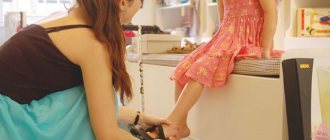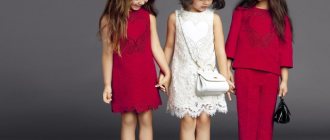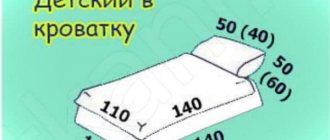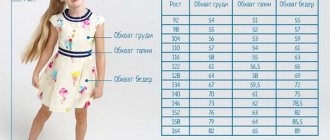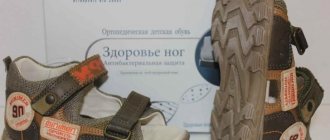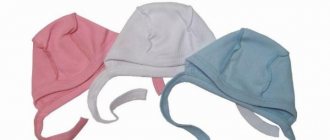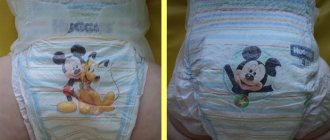Is it possible to determine a child's shoe size by age?
As you know, people of the same age can differ greatly both in height and stature, as well as in leg size. With children the situation is somewhat different. At first, children grow almost the same, and the younger they are, the faster both their height and foot length change. At the age of up to 3 years, the child’s foot increases by 2-3 sizes per year, from 3 to 6 years - by 2, after 6 years - by 1-2 annually. In order to find out the size of your baby’s feet, knowing only his age, you can use a special table.
Parents' mistakes
Buying shoes for young children often becomes a real challenge for their parents. A young child cannot yet accurately describe the sensations he experiences when trying on shoes: is it comfortable for him, does it press on his feet or not, and so on. Therefore, parents try different ways to evaluate how suitable a particular pair is for their baby. However, many of them are erroneous and will not provide the necessary information. Here are the most popular methods:
- Insert your index finger behind your baby's heel . If the toe fits, the shoe fits. This is not true. The baby does not understand what they want from him, he can bend his toes, the foot will go further, and at home, in a calm environment, it will turn out that the shoes are too small.
- Place the child's foot on the sole of the boot or boot . Depending on the model, the sole may be much larger than the insole inside. The shoes will be too small.
- Ask the child if he is comfortable . The baby may really like the boots, he will say that they are comfortable, but later it will turn out that they are pressing on him.
- Many parents buy shoes “for growing up”, i.e. obviously take a larger size. This can negatively affect the formation of the child's foot and his gait . Due to the fact that the foot is poorly fixed, its muscles will be in constant tension.
To avoid misunderstandings when choosing shoes for your baby, you need to refer to the size chart and know the length of your child’s feet.
How to correctly determine the size of children's shoes?
It is not enough to simply apply a ruler to the baby’s leg, since the resulting figure will not reflect the real picture. In fact, you just need to take a couple of simple measurements and you will get the child's actual shoe size.
Measuring the foot
In order to measure a child’s foot, you need to place a sheet of paper on a flat surface of the floor, fix it and place the child’s foot on the sheet so that all its weight rests on the foot.
Outline the leg, holding the pencil strictly perpendicular to the floor. Then measure the distance between the most prominent points of your big toe and heel. Instead of the described manipulations, you can use a special ruler to measure the foot , the main thing is to make sure that the baby rests on the leg being measured, because when walking, the foot expands and lengthens under the pressure of the child’s weight.
Important! Be sure to measure both feet, since one of them is a little larger, and when buying boots, be guided by a larger foot.
Taking leg measurements at home
You need to select children's shoes exactly by size; to do this, you will have to measure the parameters of the foot. You will need:
- place the child’s foot on a piece of paper or cardboard;
- trace along the contour with a pencil, holding the lead as close to the edge of the foot as possible;
- measure the length of the resulting contour between the two most distant points of the contour.
This way you will know the length of the insole and can use it as a guide when choosing shoes. You can clearly see the measurement process in the video:
If you plan to buy in a regular store, you should cut out the resulting blanks and compare them with the insoles of the selected pair. It is better to leave an allowance of 5-10 mm - this way the child can wear new shoes with maximum comfort. You can find out the correspondence of the insole length to the sizes in different systems (metric, inch, mass) using the tables in this article.
All about the fullness of shoes
Like adults, children's feet vary in fullness, and this factor is no less important when buying shoes than the length of the foot in cm . Different manufacturers may use different designations for fullness , for example, for domestic ones it is indicated in numbers from 1 to 12, with the step between adjacent fullness being 4 mm. Foreign ones use a letter designation, and the difference between adjacent measurements is 5 mm.
To calculate the fullness of shoes, there is a formula: W = 0.25B – 0.15C – A, where B is the circumference of the foot, C is the length of the foot, A is a constant value equal to 16.5 for children from 0 to 7 years and 13.5 for teenagers The circumference of the foot is measured with a measuring tape at its widest point (along the toes). For those who find calculations using formulas a difficult task, just check the foot circumference with the table:
How fast does the leg grow?
The child's foot does not grow evenly. Sometimes it grows slowly, but there are peculiar leaps when the height, weight and size of the child’s feet increase greatly. In this case, a pair of shoes may not be enough for the season.
Until the age of three, it is advisable to measure the length of the child’s feet every three months.
From three to six you can measure a little less often - once every 4 months.
From 6 to 10 years – once every 5-6 months is enough.
Teenagers often experience a growth spurt. Therefore, it is very important to monitor your child in order to be able to replace his shoes in time.
How to navigate Aliexpress?
When buying shoes in any online store, a logical question arises: how not to make a mistake with the size? Thousands of sellers from China list their products on Aliexpress. Many of them add instructions on how to choose the right size in the product description. The translation of this instruction into Russian can sometimes be a little confusing, but most often the general meaning is clear. What they write:
If you are still not sure about your choice, when placing an order, you can write a comment to the seller indicating the length of your foot in cm and asking them to send you the appropriate size. Read the product description carefully . For example, the name of the shoes may include “genuine leather,” but the description indicates that the material of the upper and insole is leatherette.
Important! Always read product reviews; they may contain real photographs and indicate that the seller’s sizing chart does not correspond to reality.
Systems for designating children's sizes and their differences
There are several size designation systems that differ from each other in the units of measurement of foot length and the reference point. The simplest of them is metric. The shoe size in this system is equal to the length of the foot, measured in centimeters .
The most common metric system is in Japan, China, and South Korea. Sometimes used by Russian manufacturers. In Europe and in most shoe stores in Russia they use the shtihmass sizing system , based on the name of the unit of measurement shtik, which is equal to 2/3 cm. Knowing the metric size in mm, it is easy to convert it to shtihmas, dividing by 6.67.
A little more difficult to determine on your own is the inch sizing system . The unit of measurement is a barleycorn equal to 1/3 inch or 8.47 mm. The peculiarity is that the countdown is not from 0, as we are used to, but from the minimum possible block. So, in England, where this system is used, the minimum last corresponding to the length of a newborn child’s foot is 4 inches, and in the USA it is even smaller.
In order to avoid complex measurements and calculations, it is enough to use special tables for matching shoe sizes from different countries.
How to measure a baby's foot
To accurately determine the size of a child’s feet, not so much by age as by foot length, you need to follow simple steps. Prepare a sheet of paper in advance. You will also need a regular ruler. Next follow the instructions:
- Ask your son or daughter to place both feet on the paper.
- Make sure the feet are confident and the child rests completely on them.
- Trace the outline of the feet, pressing the pencil firmly.
- Measure from the tip of your big toe to the edge of your heel.
- Check the resulting number with the table value and determine the size marking.
- Be guided by the indicators of the foot that turned out to be slightly larger.
Take measurements in the evening, when blood flow is especially good and the leg is maximally enlarged. The advantage of the described method is that you get accurate values and easily set the size indicators, regardless of the gender, age, or height of the child. Do not round the resulting number, take into account millimeters - then you will definitely not be mistaken in choosing the necessary pair of shoes.
But what about a one-month-old baby who cannot stand on his legs? Cute booties, boots, etc. are sold for such babies. They are softer and not at all stable - they simply warm the foot, like socks. Here you will have to act differently:
- Gently take the child's foot and straighten it.
- Make sure that the baby does not curl his fingers, otherwise the measurements will be incorrect.
- Using a rigid ruler, measure the distance from the tip of your big toe to the edge of your heel.
- Do the same with the second foot, focusing on the largest values.
- Check the resulting number with the indicators.
Summary table for determining the size of a child’s feet by month:
| Age (months) | Foot length(cm) | Size range |
| 0-3 | 9,5 | 16-17 |
| 3-6 | 10,5 | 17-18 |
| 6-12 | 11,7 | 19 |
| 12-18 | 12,5 | 20 |
| 18-24 | 13,4 | 21-22 |
An example of determining the size of children's shoes
Let's look at an example of how to navigate a store. Let's assume that with the correct measurement of both legs of the child you got 13.4 and 13.7 cm. Based on the larger measurement, we look for 13.7 cm in the correspondence table presented above, and see that we got a borderline size between 13.5 and 14 cm.
Remembering that shoes should not be tight, we rely on 14 cm and look at compliance with other sizing systems : these are English size 5.5, American 6.5 and European 22.5. Half European sizes are rare in stores, so we need to know in advance whether to take 22 or 23? To do this, we find out their exact measurement in cm: 22*2/3=14.67, 23*2/3=15.33, thus we got the length of the insole. As you know, the length of the insole should have a margin of about 1-1.5 cm. It turns out that if we buy summer shoes, then it is enough to take 22, and if we buy autumn or winter shoes, then 23.
The nuances of fitting
Ideally, your child should try on shoes before purchasing. But it is almost impossible to get an intelligible explanation from a child about how he feels in the shoes he is wearing. Therefore, before trying on shoes, it is best to remove the insole and place the child’s foot on it, assessing the correctness of the chosen size .
Then put on the shoes and let your child walk around the store in them for about 15 minutes . During this time, if the baby pinches somewhere, red marks will remain on the leg, and you will be able to see them. If the child feels uncomfortable during this time, he will either ask you to take off his shoes, or try to do it himself, or become capricious, which means you will need to choose a different model.
Important! It is better to go to a shoe store in the evening, when your feet swell a little and increase in size.
Table for children 1-5 years old
| Centimeters | USA | England | Europe |
| 12,7 | 5,5 | 4,5 | 21 |
| 13 | 6 | 5 | 22 |
| 13,3 | 6,5 | 5,5 | 22 |
| 14 | 7 | 6 | 23 |
| 14,3 | 7,5 | 6,5 | 23 |
| 14,6 | 8 | 7 | 24 |
| 15,2 | 8,5 | 7,5 | 25 |
| 15,6 | 9 | 8 | 25 |
| 15,9 | 9,5 | 8,5 | 26 |
| 16,5 | 10 | 9 | 27 |
| 16,8 | 10,5 | 9,5 | 27 |
| 17,1 | 11 | 10 | 28 |
| 17,8 | 11,5 | 10,5 | 29 |
| 18,1 | 12 | 11 | 30 |
Choosing children's shoes needs to be done very responsibly. So, make sure that the shoes do not squeeze the baby’s feet and are not too big. If the child is small and cannot yet tie his shoelaces, give preference to shoes with Velcro or zippers. For babies in their first year of life, there are special standards for choosing first shoes: a small heel, the heel should be securely fixed, the sole should be flexible enough. Taking into account all these features, you can choose the most comfortable shoes for your baby even without his presence.
Comments ()
Tips for choosing children's shoes
Oddly enough, the ideal shoe for a small child’s feet is its absence . Therefore, whenever possible, let your child run barefoot on the grass or sand. In the city there is practically no such opportunity, and besides summer, walking without boots in our latitude is not possible. The main function of shoes is to protect the feet from cold, injury and infection. This is why it is so important to choose the right children's shoes that will not harm the child's rapidly growing feet. Recommendations:
For the first steps, it is important to choose lightweight slippers with a very flexible sole (especially in the toe area) and a soft, breathable upper that does not restrict movement. During the process of formation, the baby's legs need freedom ;- avoid pointed and narrow noses, they can lead to foot deformation;
- a small heel from 5 to 15 mm is acceptable;
- the heel of the shoe should be firm, fixing, but not very hard;
- do not buy shoes with high backs that secure the ankle; as the child grows, the ankle joint develops and strengthens naturally;
- Buy shoes strictly according to size. Please note that this does not mean end-to-end. There should be a free space of 1-1.5 cm for the toes in length. Also, do not buy shoes “for growth”; the foot in them will experience additional stress when walking ;
- choose boots with Velcro fastener, they can easily be adjusted to the desired fullness of the leg, lacing is also suitable, but it is inconvenient because the child himself will not learn to use it for a long time;
- if the child is healthy and there are no relevant indications, there is no need to wear orthopedic shoes and insoles with arch support;
- if it is not possible to take your child with you, take a cardboard pattern of the foot, which must first be placed on the outside of the shoe on the sole, and then put inside and make sure there are no jams.
How to choose shoes?
When choosing shoes, a child needs to focus on its quality, appearance and, of course, size.
Since the baby’s leg grows very quickly, it is better to measure it immediately before going to the store. It’s better to buy with a small reserve so that you don’t have to buy a new pair in a month. However, taking a size or two larger is also not worth it. This can have a bad effect on the formation of the child’s foot and gait, because it will be uncomfortable for him.
Buying sandals is much easier, because parents can see how the foot is positioned . In this case, it is better to leave a margin of 0.5-0.8 cm. For small children, it is important that the sandals have a solid heel.
When choosing closed shoes, such as shoes, boots, boots, you can leave a margin of a little more than 1-1.2 cm, focusing on wearing a warm sock.
When choosing, you should take into account both the length and fullness of the foot, its instep. Choose suitable models.
The right shoes have a small heel and preferably an orthopedic insole.
It is better to choose a model that, when unbuttoned, is easy to put on your foot, and when buttoned, the foot is well secured.
To secure your feet, it is better to choose shoes with Velcro, because it will be easier for your baby to put on his shoes on his own. Zippers and laces are suitable for older children.
It is worth paying attention to the quality of the material from which the shoes are made. The sole of the shoe should absorb well, bend and follow the foot when walking. It is desirable that it be non-slippery and corrugated.

